#stage theories of human development
Photo

A book that’s at once both exciting because of the brilliance of its synthesis and vision, but also depressing because of how it clarifies the mental poverty of so much of current existence.
I’ve dropped almost everything else I’m reading in order to get through this before the 3 week return deadline.
The contrast between the educational philosophy of this book versus what conservative legislators (especially) are doing with education in the US is vast. (You could say this about any number of books or ideas, of course.)
It’s easy as pie to get large inarticulate numbers worked up about fantasy problems like woke and critical race theory and LGBT-themed library books, but it’s impossible to find an equivalent number with the power to push these postformal education ideas ahead.
Conventional, reactionary, conservative and authoritarian educational practices easily reproduce themselves since they’re mostly operating on low-effort duplication of current practice. Rote memorization, acquisition of sterile facts, suppression of dissent, etc., are hallmarks of this educational approach - static social reproduction.
Adopting postformal pedagogies on the other hand is in a paradoxical situation. It would seem to require significant numbers with postformal (or, using an equivalent term, postconventional) psychological and cognitive development to get it going on a mass scale, but this is hugely complicated by the fact that people functioning at postformal levels are generally lacking and might only come into existence if there were significant numbers of them to begin with in teaching positions, but if this were the case then the problem would probably be in some degree of resolution.
Examples of this paradox or dilemma are commonplace in other areas. For example, if you’re at a low or mid level in terms of your critical thinking ability, you will not be able to imagine what it’s like to have a high level ability. Thus, you don’t see your current function as necessarily problematic. Or, if you don’t understand statistics, you won’t grasp whether a given public poll is valid, relevant, significant, or otherwise.
#jennifer gidley#futures studies#postformal#postconventional#education#philosophy of education#human development#stage theories of human development#teaching
7 notes
·
View notes
Text
The Evolution of Communication
Drawing Parallels between Integral Theory and TelephonyIntegral Theory, developed by philosopher Ken Wilber, is a comprehensive framework that seeks to reconcile the diverse theories and philosophies concerning reality and human experience. It encapsulates every field of human inquiry, from art and science to morality and spirituality, drawing on multiple perspectives to provide a holistic…
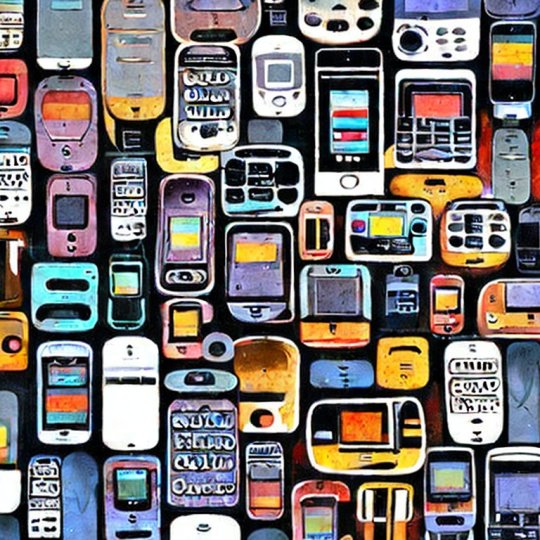
View On WordPress
#Alexander Graham Bell#Archaic Stage#Brain-Computer Interfaces#Collective Consciousness#Emergent Future#Future of Phones#Holographic Communication#Human Development#Integral Stage#Integral Theory#Integration#Ken Wilber#Landlines#Magic Stage#Mobile Phones#Mythic Stage#Pluralistic Stage#Rational Stage#Shared Evolution#Smartphones#Super-Integral Stage#Technological Advancements#Telephone Evolution#Telephony#Transcendence
0 notes
Text



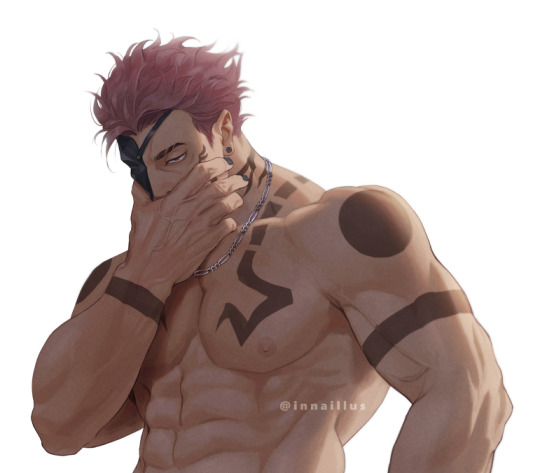

Drawing Ryōmen Sukuna
Development notes
This post has been in the making since last year, before the manga has reached its current arc. My aim was to respond to comments that pointed out that my version of that time didn't look like the one in the anime.
I calculate everything I do and the way I do it. My current goal is to share my thoughts on the development of my take on him - simply because I'm a nerd when it comes to anatomy and I love figuring things out. It involves a lot of thinking, questioning, analysis, dissecting information and building theories. So I totally understand if it's not anyone's cup of tea.
MANGA SPOILER WARNING
The very beginning
I used to have a serious case of lack of self-confidence. My earliest art of Sukuna dates back to 2021, but it always felt like my skills are not worthy of this particular character. I never shared my art. I was also struggling to find my artistic voice. I was obsessed with the idea of semi-realism, but even if I managed to pull it off after weeks of stylisation practices, I didn't like the results.
Due to personal reasons, I stopped trying to draw him for a long time.
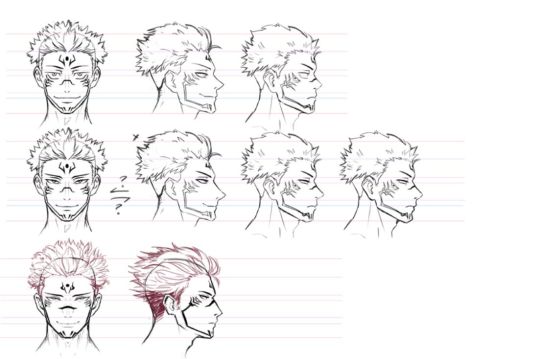

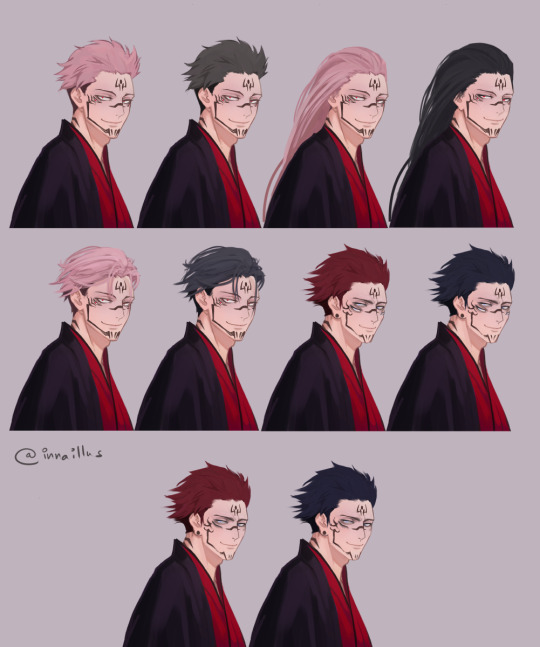

The development of "my" version

It was an entirely conscious decision to draw him differently.
The top reasons for the change was that I didn't want to sexualise him in his host, Yuuji, who is a minor. Back then I thought he inflicted the deformation on himself (extra limbs, eyes, etc), for the sake of efficiency, and I was curious what he looked like before that - or what he would look like in a civilised environment.
During the process, I considered a number of factors:
the beauty standard of the other JJK men - I wanted him to fit the lineup - his original appearance made him stand out quite much
in a setting where he adheres to the rules of society, more or less, I believe his MBTI personality type (ENTJ) would dictate a lot of his choices when it comes to appearance, at least to a certain extent. I thought he would choose to have an appearance that fits the beauty standards of the era
I kept his tattoos because it's a very distinguishing feature of him, but I also exercise freedom in the way I draw them, to make them as stylish as possible

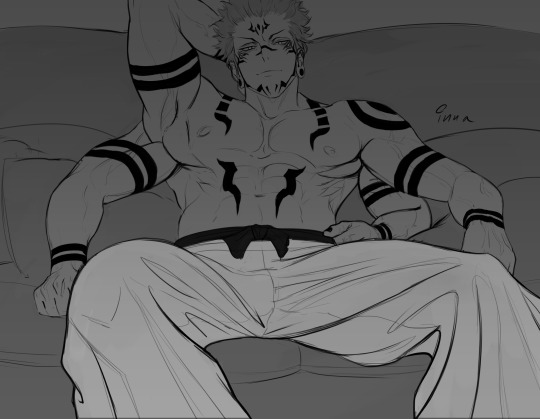
Reincarnation
I used to believe once he reincarnates, his proportions would be closer to that of a "normal" human, even if he has some extra limbs. However, his size and features are above and beyond of what we are used to, and even the story emphasises their malformed appearance. So a a whole new era of Sukuna started in my art. I chose my favourite manga panels of him and mix-and-matched the most attractive features into a figure that I consider on the fine edge of monstrosity and unconventional handsomeness.
Even when I draw him with a regular number of limbs, I keep his usual mass and proportions. I dubbed this form "true gains" form.
I also realised that some of the tattoos Yuuji's body displayed was a product of the partial reincarnation stage, like we see it on Tsumiki's forehead.
NOTE: Did anyone notice that Sukuna is getting progressively more and more human/handsome in the manga? When he took over Megumi's body, I also noticed that as the story progressed, he started to look older and more mature. I'm curious of it was a conscious decision.


Twin dilemma and speculations
According to the Japanese wikipedia page, the mythical figure Sukuna could have been a conjoined twin. Despite my extensive digging in the matter, I was shocked by the recent lore drop.
My question: what does Sukuna look like in a universe where he did not absorb his twin in the womb during development?
It hasn't been confirmed, but I find it very possible now that he was born with his extra limbs, eyes and mouth, as well as the deformed, wide features. (...as opposed to my first theory about him altering his own body for the sake of efficiency)
This, however, would mean that in a universe where both him and his brother are born healthily, he would look different. There is the obvious lack of extra arms, eyes and mouth - but I believe he would also be closer to the JJK beauty standard of men, as far as proportions go (eg. more narrow face, anime-esque nose, larger eyes).
At first I was hesitant to accept this idea, as I'm very attached to the 4-arm hulk / "true gains" form now, but then I realised: this would mean that "my"version of him actually has logically explainable place in at least an alternate universe.
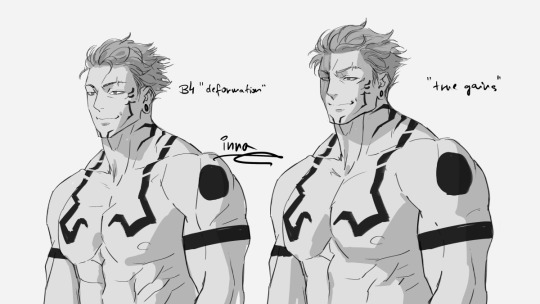
Thank you if you got this far.
I may edit this post later. Let's see where the story takes us.

294 notes
·
View notes
Text
guys, i have good news for once. i've found proof of intelligent life out here in these wastelands:
my favorite excerpts:
Will, Jonathan, and Joyce Formed a Special Trio
If Eleven is the main character in Stranger Things, the Byers family is the conduit through which she flickers. Will’s disappearance in the first season spurred the Hawkins community to rush to his aid.
The tight-knit camaraderie between Will, Jonathan, and Joyce juxtaposes the stereotypical family composed of kids and teenagers. Parents and children are supposed to fight and bicker in television and other media, often to build the main conflict of the story, but the Byers family already underwent that trauma offscreen.
Lonnie Byers (Ross Partridge) makes a brief cameo in the first season, flexing his standoffish demeanor and abusive nature. It’s clear that the Byers patriarch doesn’t possess much empathy for his ex-wife or his sons. Jonathan valiantly steps into the father, husband, and big brother role, amalgamating into a combination of responsibilities that no other character on the show could dream of emulating.
Jonathan Binds the Byers Family Together
Jonathan’s multifaceted arc in the first two seasons made him one of the series’ most easily dissectable characters. Stranger Things often differentiates itself from other shows by keeping the antagonists separate from the main characters. There are no Walter White or Tony Soprano-style antiheroes in which fans must compromise one part of their moral compass to appreciate the character.
One might think this makes the series boring, but it’s the opposite. Jonathan was proof that a nearly perfect brother and son can still be fascinating to watch. After Will was found in season 1’s climax, he was taken over by the Mind Flayer in season 2. Jonathan again stood by Will’s side as his little brother felt outcasted by friends and society at large. Schnapp and Heaton’s chemistry often leads to tender, humorous exchanges like this one in which the boys remind the audience that being weird can be a human superpower in its own right.
These moments became few and far between in seasons 3 and 4. Will and Jonathan were relegated to minor supporting characters as the aforementioned new additions took center stage. Will at least gets to tag along with Mike, Dustin, Lucas, and the other younger friends. Jonathan often only appears in a few small scenes with his girlfriend Nancy (Natalia Dyer), and the writers even flirted with pushing Nancy back into Steve’s arms in the most recent season. Jonathan spent the majority of season 4 high on marijuana and frolicking around in a faux buddy-comedy routine with the one-off character Argyle (Eduardo Franco).
The decision to waste Heaton’s work from the first two seasons with a 180-degree personality change made no sense. Jonathan suddenly seemed careless, distant, and uninspired, but not in a dense way that could be unlocked by further character development. Little-to-no time was spent on him. While some fans might concur it is a necessary evil to take screen time away from older characters when expanding the world of Hawkins, it certainly transforms Stranger Things from a show about family into a show just about monsters and romances.
Jonathan’s Enhanced Role in Season 5?
Many theories point to Will being one of the critical pieces to defeating Vecna (Jamie Campbell Bower) in the fifth and final season. His connection to the Upside Down and the evils underneath the surface should open up opportunities for Jonathan to lend his ears and counseling once again. Jonathan grows on an individual level when he aids others. When locked out of his family’s life, it stunts his ability to shine as a listener and an empathizer.
Jonathan’s best scene from season 4 again features a tear-jerking moment with Will. On the cusp of coming out of the closet, Will needs Jonathan more than ever before, and his brother responds supremely to the task at hand. The poignant conversation validates that the Duffers haven’t completely forgotten how to flesh out the Byers family. When the world gets too enormous for the characters and the audience, Jonathan serves as a connector to the most human elements of the series’ thematic thesis.
He may not be as funny as Steve or as neurotic as Robin, but Jonathan symbolizes the good in all of us. In a show shrouded in darkness, Jonathan’s presence will be instrumental to forming a satisfying, optimistic conclusion in Hawkins, Indiana.
#st#stranger things#jonathan byers#if everyone and the duffers would listen to what me and my fellow jonathan warriors have been preaching and praying and saying#reading jonathan appreciation is like getting injected directly in the heart with adrenaline it makes me feel like a sports fan whose team#just won and now must destroy a city over it . or whatever
149 notes
·
View notes
Text
𝕿𝖍𝖊 𝖊𝖛𝖔𝖑𝖚𝖙𝖎𝖔𝖓 𝖔𝖋 𝖘𝖕𝖊𝖈𝖎𝖊𝖘

sinopse:The curious case of the prefect of Ramcharcke raises theories and hypotheses, and each has a basis for it. Which one will be right? What do you believe in?
Characters: NRC Staff,Dire Crowley, Divus Crewel, Mozus Trein, Asthon Vargas, Sam.


“𝙏𝙝𝙚 𝙢𝙖𝙣 𝙞𝙨 𝙗𝙖𝙙 𝙗𝙮 𝙣𝙖𝙩𝙪𝙧𝙚 𝙪𝙣𝙡𝙚𝙨𝙨 𝙝𝙚 𝙣𝙚𝙚𝙙𝙨 𝙩𝙤 𝙗𝙚 𝙜𝙤𝙤𝙙”
Crowley completely agrees with the said philosopher, as a director of a renowned school built on the controversial values of historical figures. He KNOWS that every NRC student is a place full of angry, arrogant, hormone-bombed teenagers, which is why he is so magnificently kind to Yuu. Who would give a complete stranger a place to sleep without magic? Who would do everything to make Yuu return to her beloved world even if it cost hours of work? Oh, how generous the director is, right?
For some reason, Yuu is managing to keep well. Survival is the word that would best define this situation. Now how she is managing to do this is difficult to talk about. At some point the director thought of carefully analyzing the case of the strange student without magic. In a school with cruel students, you, Yuu, are the only one with altruistic thinking and no magic. Why would the carriage that has never made a mistake in all these centuries of power bring a person like that with no aspect other than the basics? Unless…
Yuu has the potential to be evil in her own world, but not in this one where she is in a clearly vulnerable position, Crowley concluded and fell deeper into his reveries. So to survive you will have to adopt a good and pure image until you have enough strength to overcome your enemies, little by little, until you reach the top of the chain. Like every human being he has ever encountered in his secular life, Crowley feels that the thirst for power and blood is deep inside in Yuu. That's why he sends her to do various dangerous jobs and jobs, disguised traps. It's like a challenge: How far the wolf in sheep's clothing go? Roll your dice and place your bets, as Director Crowley will be keeping an eye on you.
“𝙈𝙖𝙣 𝙞𝙨 𝙜𝙤𝙤𝙙 𝙗𝙮 𝙣𝙖𝙩𝙪𝙧𝙚, 𝙨𝙤𝙘𝙞𝙚𝙩𝙮 𝙘𝙤𝙧𝙧𝙪𝙥𝙩𝙨 𝙝𝙞𝙢”
Perhaps in the analytical mind of the cruel chemistry teacher, Crewel, he had gone through the stages of denial and finally surrendered to the illusion. Yuu is a sweet and hardworking girl. That's it. Period. They had some time to develop a complicated relationship of father and daughter, mentor and student, but when Divus accepted his “fated role” according to him, it was a one-way thing. He will not allow any rowdy cub to offend her with repulsive lies. Did Yuu poison the students? Yuu blew up old bullying rooms? Did Yuu cheat on tests and manipulate students? LIES! She was just defending herself. His precious little puppy would never submit to such a low attitude.
His “filhota”, a term he learned from her, isn't like that, is it? So stay away from these disobedient puppies Yuu, they tarnish your image, dear.
“𝙈𝙖𝙣 𝙞𝙨 𝙗𝙤𝙧𝙣 𝙖𝙨 𝙖 𝙗𝙡𝙖𝙣𝙠 𝙨𝙝𝙚𝙚𝙩 𝙤𝙛 𝙥𝙖𝙥𝙚𝙧”
Trein not only agrees with this theory, but he could prove it from a very practical experience: Yuu.
Having raised his own family, two daughters, a cat and being an experienced teacher at school for years, he knows how to masterfully recognize each type of student in his class: The nerd, the clown, the teacher's pet, the one who doesn't know anything about nothing, the one who knows everything, the one who pretends to know everything, the lazy and many others….but what about Yuu? How does she characterize herself in this group of characters?
What a curious case, a student without any kind of magic, with few memories, and in a school of arrogant boys without any support? How did she survive for so long? How does she adapt so easily? One day she's a nobody, and the next she has contacts with important princes and shady merchants. One day she knows nothing about the world that has stopped, and the next she knows more than Trein himself in his years of apprenticeship. In some way or another the stranger knows every secret of every hallway in the school, and holds them in the palm of her calloused hand.
The blank figure has immense potential for creation and destruction, and something tells Trey that the foreigner's innocent look and sharp tongue have dangerous odds.
"𝙈𝙖𝙣 𝙞𝙨 𝙖 𝙧𝙤𝙥𝙚 𝙨𝙩𝙧𝙚𝙩𝙘𝙝𝙚𝙙 𝙗𝙚𝙩𝙬𝙚𝙚𝙣 𝙢𝙖𝙣 𝙖𝙣𝙙 𝙨𝙪𝙥𝙚𝙧𝙢𝙖𝙣"
Vargas could not agree with this theory more truthfully! The human body is designed to be challenged every day, and what would be the limit? As the trainer of every type of creature, from beastmen, fairies, merfolk, humans, hybrids and everything in between, he can say with certainty that there is nothing more rewarding than seeing a student overcome their obstacles!
The chest was filled with pride when he closely analyzed Yuu's case. He clearly remembered the student's first days at school, her steps were so light that the wind would carry her away, so weak and malnourished that she wouldn't walk a complete circle around the field without fainting, her look scared, her breathing heavy. She couldn't fly any higher than Azul and every time she spoke, her voice was shaky, like a kitten learning to meow.
Just look at the overcoming! Not only are her steps firm and determined, but she runs very fast as well. And even when an envious person tries to push him in a competition, she pushes him harder, making him fall to the ground. 12 eggs a day. 12 EGGS PER DAY. A diet that the trainer himself follows and just look at the results. The prey body has evolved into that of a hunter. Big, strong, fast and adaptable. Perfect.
Maybe you should be worried about the way she beats the past bullies who tormented her blue and purple? The way she hunts them is different, it's personal, it's physical, it's animal.
It seems like the game has changed, doesn't it?
“𝙈𝙖𝙣 𝙞𝙨 𝙢𝙖𝙣’𝙨 𝙬𝙤𝙡𝙛”
The friends on the other side tell every secret and gossip that leaves the salesman, Sam, astonished. Sometimes it's hard to believe, other times he has to check it out with his own eyes. But for Sam, it's much more fun and engaging to analyze the situation like a grotesque soap opera. Each “little thing” is a sign for the next chapter. One day, among the hygiene products that are intended just for her, Yuu bought a different knife, an enchanted amulet and cans of a different type of fish and also a bottle of rat poison. Would it be for the rats of Ramshackle?.... No, the friends on the other side said that Yuu made an alliance with the rats, and so, she gets more information from the school. What type of information? who knows? For what? What will she do with the poison then? Pay attention to the next chapters.
A shadow wandering around in the morning once commented that on one of Jack's morning walks, he commented to Yuu that she "seemed to adapt to Twisted Wonderland fairly quickly.." And as soon as he found out, he ran as fast as his ghostly figure allowed him, so determined to be the first to tell Sam a hot piece of gossip that he didn't stay until the end of the conversation, and consequently left the merchant and his friends on the other side curious to know what Yuu's answer is.
Is Yuu letting her changes show to her troublemaking first-year friends, or has she tried to keep a mask on for a while? We cannot deny that her “strange” behavior is commendable for analysis. The one who enters the lion's den and comes out intact, the one who melts the heart of an evil icy queen, the one who entered as a sacrificial lamb and came back as the leader of the pack. Ohhh~~what interesting character development! More and more shadows surround Yuu now, watchful and thirsty for her next steps.

(っ◔◡◔)っ ♥ Every like, repost and comment is very welcome and appreciated. ♥
#twisted wonderland#disney twst#twst#disney twisted wonderland#twst yuu#malleus draconia#ace trappola#leona kingscholar x reader#twist x reader#malleus x reader#crowley#twst divus#divus crewel#mozus trein#vargas twst#sam twst#divus twst#yuu#twst mc#twst grim#twst wonderland#teories#disney#reader insert#teorias de yuu#twst incorrect quotes
288 notes
·
View notes
Note
👀👀 wanna say more about your eusocial timelord theory?
when you sent this ask like a year ago apparently I did not, for which I apologize.
now it's the wee small hours and I'm trying to clear out my asks. but eusocial time lords are so fun. forgive anything that doesn't make sense/jars weirdly in this, I'm trying to explain some quite spitbally worldbuilding.
among other things, it's an explanation for (1) why are there so few time ladies on screen and (2) that very strange thing in I think it's in Gallifrey where Pandora was 'the first female President' and apparently that's a big deal? but like why would a different planet (where they regenerate!!) have the same manifestations of sexism as we have? and also vaguely riffing on the VNAs lore that Gallifrey used to be a matriarchy and Rassilon overthrew it, but also kind of completely transforming that lore.
so forget gender, this is not about gender. "male"/"female" is at best a very rough translation of the binary that Gallifreyans are concerned with, which is worker/queen. They are bees!
The Time Ladies (i.e. Gallifreyans played by female human actors) that we see in the pre-War era (all of this applies to the pre-War era)--Romana, the Rani, Flavia, Inquisitor Darkel--are biologically the equivalent of insect queens. (And the Doctor, the Master, Borusa, the Floating Time Lord, Commander Maxil, etc. etc. are the equivalent of worker bees. The fact that the former all present as female and the latter all present as male is just sort of a translation convention/useful coincidence, I guess.) Gallifreyans evolved from a eusocial species and their early political structures were developments of the hive structure, with reproductive capacity strongly linked to political authority.
Presumably this is what Rassilon, or whatever revolutionary Rassilon stole credit from, is supposed to have overturned--the link between reproductive capacity and political authority. But in my version, it was before that that Looming became a thing: the queens had control of the Looms, so it was the ultimate refinement of their arts and sciences, and it was their way of getting rid of whatever drone class there used to be, if they weren't already parthenogenetic.
And that's why there's the stereotype in Gallifrey--mentioned in connection with Pandora, suggested as a concern about Romana--that a "female" (queen) President will be autocratic. It's seen as a potential return to "how things once were."
And then I did a lot of worldbuilding for how government worked at a stage in history when there was a sort of uneasy balance between reproductive and political power, but that was for a fic Moki was working on and I think she's still working on it, so no spoilers!
So what you end up with is a hive structure where the role of the queen has been sort of abstracted away into... well, the hive itself. The power at the heart of Gallifrey is Gallifrey. I feel like that explains a lot of what's wrong with them.
There might be another branch of the species that evolved away from eusocial structure into something more like solitary bees and that's the Shobogans, possibly, since nobody seems at all clear what the Shobogans are.
Also I read that with naked mole rats, the only eusocial mammal, there are a few in each colony that are predisposed to not fit into the colony and instead go and wander and find other colonies, to promote genetic diversity, and I'm just saying, renegades.
And after the War when there are often maybe two Gallifreyans left, that's why whatever's left of the hivemind keeps trying to get at least one of them to turn out as a Time Lady. Fortunately for the universe, neither of them seems that interested in reproducing.
425 notes
·
View notes
Note
Hi! I really like your other takes on Underdark races, and wanted to ask if you had any thoughts on improving grimlocks? Beyond the permanent blindness they have and the whole being humans who adapted to the underdark, there doesn't seem to be a whole lot else done with them.

Monsters Reimagined: Grimlocks
Would it surprise anyone to learn that a d-list d&d monster has It's roots in 1800s ideas about eugenics and bad adaptations of genre fiction? No? Then you've been paying attention, top marks.
Asker is absolutely right in their assessment that there's not really much to grimlocks. They're one of many "hostile tribal primitives" that have filled out the monster roster ever since the original developers lifted them en mass from the pulp adventure stories they grew up reading.
A common theme among these pulp works and the early scifi that inspired it was devolution, the idea that a people could degrade from greatness back into an animistic nature. The most well known pop culture example would be HP lovecraft's deep ones, where the author's fears of race mixing manifest as monsters that literally push humanity back down the evolutionary ladder to the stage of fish.
There's plenty of different ways to explain the origin of this writing trend, but I like to chalk it up to an anxiety resulting from the widespread acceptance of Darwin's theory of evolution by a society that believed wholeheartedly in scientific racism. If intelligence (read: whiteness) wasn't just a god given right but was infact inheritable, then it could also be disinherited, bred out of a population whether by on purpose or by accident. This made it so important to practice good breeding (read: eugenics), to preserve the pure stock from falling to degeneracy (read: miscegenation) and introducing undesirable traits into the genepool.
We can see fear this with grimlocks, humanoids who were inherently lessened by their "adaptation" to life underground, losing their intelligence and eyesight and descending into a state of barbarism. Given that this is one of the few d&d monsters that mention evolution at all, we can trace this feature to their likely inspiration: The morlocks in H.G. Wells' Time machine, published a scant 36 years after Darwin published The Origin of Species.
I'm not well read enough to know whether Wells pioneered the idea of subhuman descendants, but I can say that most of his imitators missed the point of his writing: Wells saw in his day an increasingly indolent upper class inflicting brutal and dehumanizing labour conditions on the poor to support their own carefree lifestyle. He satirized this in his book by showing that while the descendants of the rich had devolved into beautiful, useless, idiots, the descendants of the workers devolved into subterranean ape-things who maintained the machinery that allowed the eden like existence of the rich while farming them for meat. Say what you will about Wells' race politics (Neither degenerate fop or inbred ape can withstand the smarts and strength of the enlightened colonial Englishman) but his writing was specifically class continuous, and the brutality of the morlocks was a direct result of the exploitation of working people in his own day and age.
When the morlocks were adapted into the grimlocks , the d&d writers kept their canibalistic streak but specifically removed their class based origins as well as their mechanical knowhow. This is a near identical process to what happened with a creature the worlocks helped inspire: Tolkien's orcs, which were likewise turned from a commentary on the brutality of the industrial age into warlike primitives. It's a bit of a trend.
If you wanted to "fix" the grimlocks I'd go one of two ways:
If you want to engage with themes of primality, make them legit underdark dwelling primates/australopithecus type of creatures, just figuring out tool use and language. Make the rumours of them being descended from cave-exploring humanoids a common myth made up by surface dwellers.
If you want to get spicy about it though, give them back their mechanical aptitude and maybe mix in a few more dashes of pulp "lost civilization" ancient aliens nonsense. Have them dwell in great mechanical complexes beneath the earth, worker drones who've long outlived the creatures that enslaved them and scribed mechanical knowledge into their very being. Originally denied understanding of the machines they toiled to build, work, and maintain, the grimlocks jealously guard the science they've spent generations reverse engineering, giving them the reputation of being violently territorial for those underdark travelers who venture too close to the megastructures they inhabit.
Artsource
#monsters reimagined#grimlocks#the orc dissertation#underdark#dnd#dungeons and dragons#d&d#ttprg#pathfinder
137 notes
·
View notes
Text
There's been SO much... "Confusion" in the MD fandom about the ages for these drones and etc. Mainly, using it as an excuse to say Uzi x N is a bad ship for being different ages. So I've been collecting data and found the final peice that links them all together!
So for starts, the developers of Murder Drones have confirmation about how old the students are in episode 3 with the missing persons posters. As well as commentary about Uzi and her friends/peers ranging from 18-21.

Not to mention in epsiode 4, N says this...

At first I thought, maybe they chose to live a highschool lifestyle, but that made no sense. Like who wants that!? The only parts I liked about high shool was production and being with my friends almost every day. But then I remembered a factoid I once looked into that referse to this image here.
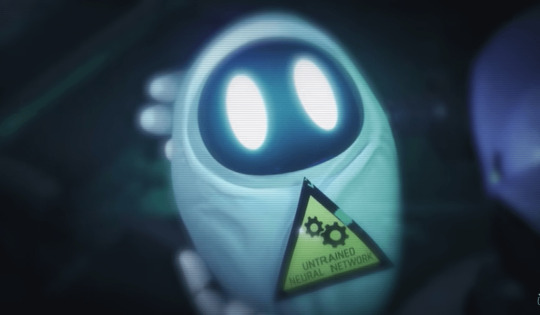
The sign on the baby reads "untrained neural network". Which is a parallel to the human brain. We ourselves start with an untrained neural network, and old science would have us believe that the brain stops developing by 16 or 18. Probably just to put kids to work faster legally. However, more modern studies and rigorous testing has lead us to a better truth about how the teen brain is still developing into the mid-20's.
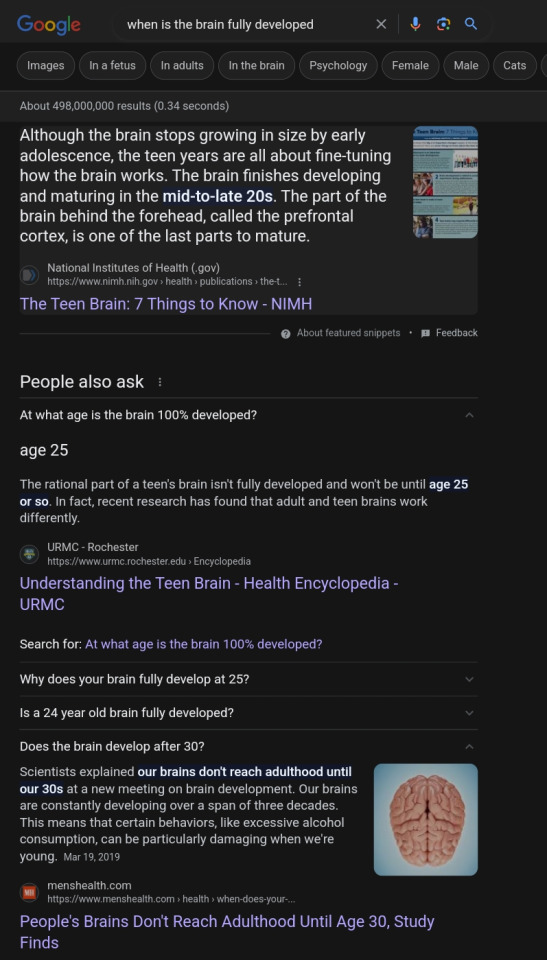
Following this information it's the most logical theory that the drones of Copper 9 do not play by human society's rules of "teens reach adulthood at 18", but instead follow the science of when their neural network is trained enough to begin developing as an adult brain.
Uzi, N, and V are still developing their neural networks and is still in the teen brain stage of their lives. Technically making them kids.
And THAT'S how I believe the age system works in murder drones! But hey, that's just a theory. A FILM THEORY! (not really I just wanted to say that. Lol.)

#a murder drones theory#murder drones#drones ages#teenager brains#uzi doorman#serial designation n#theory#Human society stinks#Lol
163 notes
·
View notes
Text
I still like the interpretation that God favours Aziraphale and Crowley, and is sort-of preventing Aziraphale from Fallling properly for his little indulgences, because they both have Free Will.
God created Humans with Free Will - not Angels, and therefore, not Demons either.
Well. Except Aziraphale and Crowley - it can be seen as them ‘going native’ from exposure to Humans, being able to make their own choices now, but I think it goes deeper.
Crowley has clearly been comfortable with exerting his Free Will and defying Hell since the very Beginning - emphasised most, I think, in the Job minisode, where he’s already settled into the ‘I’m on my own side’ routine and it feels like he’s been disobeying Hell for a good while. And if i may tie this into the Crowley is Lucifer theory for a second, he’d be the first Angel to ever develop Free Will, which is what led to him falling in the first place. He has something no Angel or Demon has - imagination. He’s been unique in his ability to ask questions from the very start.
But Aziraphale also had it from the start. He gave away his sword. He acted on his own internal sense of Right, of Good, that was separate from Heaven’s wishes at the Beginning. People have already made observations about the ‘I gave it away’ moment from S1E1 as the moment Crowley fell in love, but it goes deeper than that. This is where Crowley realises that he’s NOT the only Angel to ever develop Free Will. This Angel, who’d previously warned him off asking questions like any other would’ve, had an Inkling of human choice in him (a choice that led to the birth of violence and the Sword becoming the symbol of war, unintentionally).
THAT is why Crowley became interested in Aziraphale. That’s why he sought him out at Noah’s arc, to talk to the only other Celestial Being capable of choosing like he could. It’s why he stuck to Aziraphale during the Job fiasco. He was nurturing that part of him, encouraging his Free Will to blossom. Introducing him to human food. Letting him see what he could do with it. It’s also why he doesn’t want Aziraphale to Fall - obviously, Crowley is heavily protective of his Angel, but at that early stage he also doesn’t want the only Angel with Free Will left in Heaven to suffer the same fate he did.
The part of Aziraphale Crowley fell in love with was his ability to choose. His free will. His silly little requests like asking him to miracle away a paint stain when he could do it himself, enjoying food so immensely, assisting Aziraphale in a dangerous magic trick because he CHOSE to do it, because he said ‘Trust Me’, all his little quirks and their arguments and the exceedingly HUMAN behaviours he’s picked up over the years. Crowley loves Aziraphale as Aziraphale, not the Angel.
And despite himself, its also what Aziraphale loves about Crowley. He loves Crowley for Crowley’s Goodness - what he doesn’t understand is that Crowley’s Goodness isn’t Heaven’s Goodness. Heaven’s Goodness is the Goodness that drowned the world. Heaven’s Goodness is the Goodness that wanted Job’s children dead. Heaven’s Goodness with leave the world just as destroyed as Hell’s Evil.
But he doesn’t realise that. Not yet, anyway. And, as an Angel with Free Will, why wouldn’t you want him for the Second Coming?
#crowley#good omens#good omens spoilers#good omens 2#good omens 2 spoilers#aziraphale#ineffable husbands#hnnng brain go whirrrr#this also ties really well into the Crowley is Lucifer theory#so do with that what you will
199 notes
·
View notes
Text
Scully's Abduction, Emily Sim, and the Lost Scully Baby
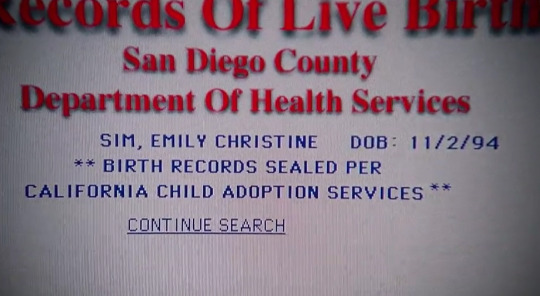
SOLVING SCULLY'S ABDUCTION DATES
The answer to the question of when Scully was returned differs here and there. Sometime after 11/2/94 and on or before 11/11/94 seems to be the consensus: themareks posits November 2nd, xfilestimeline.net guesses in-between the 2nd and 11th, and epguides stands by the 11th as both One Breath's airdate and Scully's reappearance.
But how long was Scully gone?
Mulder states in Emily: "She [Scully] was missing for four weeks. That's documented in the file."
And to further back up that abduction timeline, Mulder later finds a medical paperwork in the nursing home containing Scully's full name next to a possible abduction date: 13/10/94. At the very least, October 13 was when the government tagged her in their system, meaning Scully was likely abducted on the 12th or 13th and returned not on the 2nd but on the 11th.

WAS SCULLY IMPREGNATED DURING HER ABDUCTION?
Mulder's filed report contains another tidbit he never shared with his partner: it states (as read aloud by the official overseeing Emily's custody case) that Scully was "subjected to a series of experiments where... they extracted her ova."

The episode divulges the 'how's a few scenes later: abductees or unwitting volunteers were put into "beauty sleep" by the Syndicate doctors before being injected with a series of enhanced drugs to stimulate ovulation for extraction. Essentially, the women were put through a process similar to the early stages of IVF treatments, for far more nefarious purposes.
After the extracted ova were combined with suitable sperm or cloned with alien DNA, they were not returned to the womb but were instead grown separately in metal and glass containers filled with a green-not-gray alien liquid.
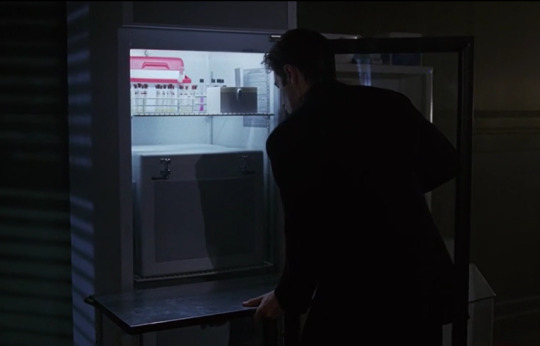
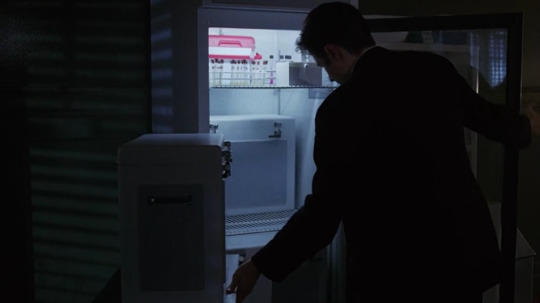
NURSING HOME MOTHERS
As is the end result of man playing God, the Syndicate pushed the bounds of their "science" by dabbling with the unconscionable: they darkened the doors of nursing homes, developing an extra preceding step that involved "awakening" and growing the ova of older women to maturation before subjecting them to the "beauty sleep." These women were the perfect targets, either too confused or too forgetful to intelligently articulate what was happening to them; and Dr. Calderon and his cohorts banked on repeating their experimental process for unlimited ova until death claimed their patients in natural or unnatural ways. (Unfortunately for Dr. Calderon, his aspirations were cut short when Mulder threatened exposure.)
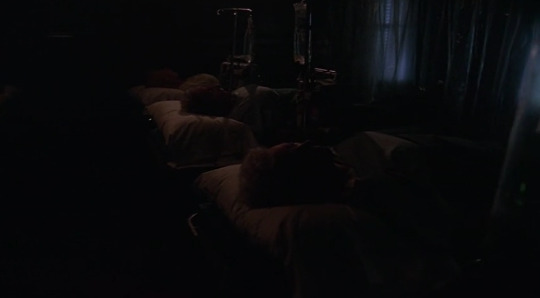
So, to recap: the women were violated, not impregnated.
THE ROANOKE SCULLY
What's even worse?
While investigating the nursing home, Mulder not only finds the aforementioned paperwork listing Scully's full name and possible abduction date but also a corresponding fetus, alive and kicking, in its own little container of green fluid.
This, too, was Scully's child; and it, too, was likely killed or discarded as medical waste during the Consortium's coverup.

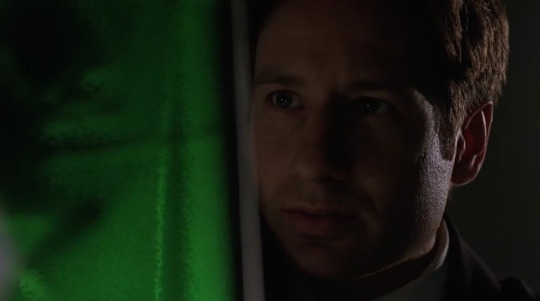
"NATURAL", CLONE, OR HYBRID?
Though not entirely explained in Emily (or after), the fetuses grew at unimaginably rapid rates from conception to "birth" in a month's time; but the cost of accelerated growth sacrificed their health, causing the babies born to be dependent on consistent injections of their mysterious gestation fluid in order to survive.
What were those babies, then? Clones? Hybrids? Fully human?
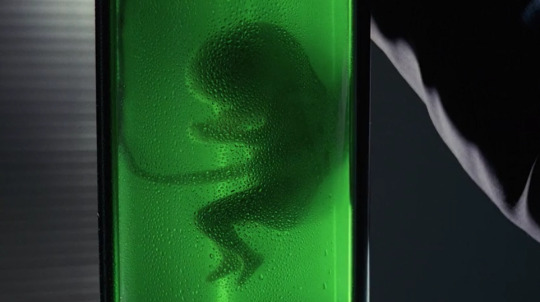
My personal theory? Emily was a hybrid. Not only would this fit the injections and extractions and underhanded IVF machinations in Season 8 (quality of its writing aside), but it would also correlate the mirroring aims of Emily's Dr. Calderon and Per Manum's Dr. Parenti. Parenti stuffed his batch of alien-human hybrid babies into identical containers of fluid, too (albeit for darker purposes.)
The episodes she appears in provides evidence of its own. Even though clones created from alien DNA bleed green and Emily bled red, her blood still released toxic fumes for self-defense, which means Emily's DNA couldn't have been fully human even if both ova and sperm were tampered with before insemination (a feat the Syndicate couldn't accomplish despite their many, many horrific attempts.)
CONCLUSIONS
Not only was Scully never pregnant but she was also never abducted more than once, making her an anomaly even amongst the other MUFON women. This leads me to believe the first round of experimentation inflicted on her was so severe that the Syndicate deemed Scully too great a risk for future harvesting... which was also likely why she was left to die (even if CSM "returned her to you" for a merciful death surrounded by the ones she loved.) Serving no further purpose to the Project, she had been considered waste and was, therefore, disposable.
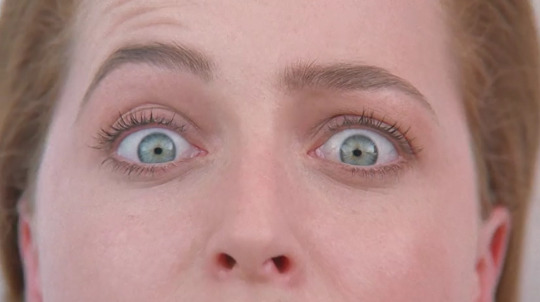
Emily, too, was ultimately doomed to die after the Consortium or Dr. Calderon tired of his experiments; and if it hadn't been for Melissa Scully's ghostly interference, Emily Sim would have been torn from her parents the minute they stopped towing the line and raised elsewhere as a lab rat-- unloved and, again, tossed aside when deemed no longer necessary.

Finally, there's still one Scully child unaccounted for.
Existence begun and ended in obscurity, it was likely squirreled away or destroyed along with any remaining evidence of Dr. Calderon's work-- a loose end from a man no longer needed by his overlords.
However, the thought that Mulder was the only person other than its merciless creators to behold this tiny fetus is one best pondered on a dark, lonely night when one is in the mood for either melancholy or heart failure.
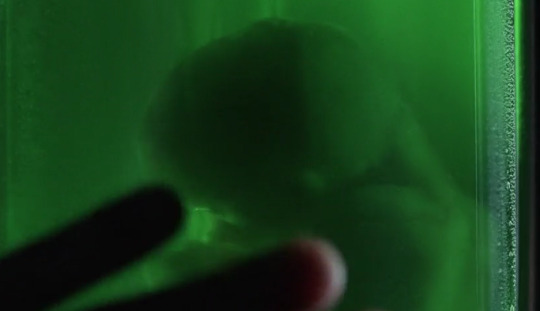
Thank you for reading~
Enjoy!
#txf#xf meta#mine#meta#xfiles#Scully's Abduction Emily Sim and the Lost Scully Baby#x-files#the x files#S2#Ascension#One Breath#S5#A Christmas Carol#Emily#Emily Sim#Scully#Mulder#Consortium#Syndicate#dates#timeline
61 notes
·
View notes
Text
2024 Book Review #4 – War in Human Civilization by Azar Gat
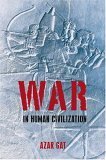
This is my first big history book of the year, and one I’ve been rather looking forward to getting to for some time now. Its claimed subject matter – the whole scope of war and violent conflict across the history of humanity – is ambitious enough to be intriguing, and it was cited and recommended by Bret Devereaux, whose writing I’m generally a huge fan of. Of course, he recommended The Bright Ages too, and that was one of my worst reads of last year – apparently something I should have learned my lesson from. This is, bluntly, not a good book – the first half is bad but at least interesting, while the remainder is only really worth reading as a time capsule of early 2000s academic writing and hegemonic politics.
The book purports to be a survey of warfare from the evolution of homo sapiens sapiens through to the (then) present, drawing together studies from several different fields to draw new conclusions and a novel synthesis that none of the authors being drawn from had ever had the context to see – which in retrospect really should have been a big enough collection of dramatically waving red flags to make me put it down then and there. It starts with a lengthy consideration of conflict in humanity’s ‘evolutionary state of nature’ – the long myriads between the evolution of the modern species and the neolithic revolution – which he holds is the environment where the habits, drives and instincts of ‘human nature’ were set and have yet to significantly diverge from. He does this by comparing conflict in other social megafauna (mostly but not entirely primates), archaeology, and analogizing from the anthropological accounts we have of fairly isolated/’untainted’ hunter gatherers in the historical record.
From there, he goes on through the different stages of human development – he takes a bit of pain at one point to disavow believing in ‘stagism’ or modernization theory, but then he discusses things entirely in terms of ‘relative time’ and makes the idea that Haida in 17th century PNW North America are pretty much comparable to pre-agriculture inhabitants of Mesopotamia, so I’m not entirely sure what he’s actually trying to disavow – and how warfare evolved in each. His central thesis is that the fundamental causes of war are essentially the same as they were for hunter-gatherer bands on the savanna, only appearing to have changed because of how they have been warped and filtered by cultural and technological evolution. This is followed with a lengthy discussion of the 19th and 20th centuries that mostly boils down to trying to defend that contention and to argue that, contrary to what the world wars would have you believe, modernity is in fact significantly more peaceful than any epoch to precede it. The book then concludes with a discussion of terrorism and WMDs that mostly serves to remind you it was written right after 9/11.
So, lets start with the good. The book’s discussion of rates of violence in the random grab-bag of premodern societies used as case studies and the archaeological evidence gathered makes a very convincing case that murder and war are hardly specific ills of civilization, and that per capita feuds and raids in non-state societies were as- or more- deadly than interstate warfare averaged out over similar periods of time (though Gat gets clumsy and takes the point rather too far at times). The description of different systems of warfare that ten to reoccur across history in similar social and technological conditions is likewise very interesting and analytically useful, even if you’re skeptical of his causal explanations for why.
If you’re interested in academic inside baseball, a fairly large chunk of the book is also just shadowboxing against unnamed interlocutors and advancing bold positions like ‘engaging in warfare can absolutely be a rational choice that does you and yours significant good, for example Genghis Khan-’, an argument which there are apparently people on the other side of.
Of course all that value requires taking Gat at his word, which leads to the book’s largest and most overwhelming problem – he’s sloppy. Reading through the book, you notice all manner of little incidental facts he’s gotten wrong or oversimplified to the point where it’s basically the same thing – my favourites are listing early modern Poland as a coherent national state, and characterizing US interventions in early 20th century Central America as attempts to impose democracy. To a degree, this is probably inevitable in a book with such a massive subject matter, but the number I (a total amateur with an undergraduate education) noticed on a casual read - and more damningly the fact that every one of them made things easier or simpler for him to fit within his thesis - means that I really can’t be sure how much to trust anything he writes.
I mentioned above that I got this off a recommendation from Bret Devereaux’s blog. Specifically, I got it from his series on the ‘Fremen Mirage’ – his term for the enduring cultural trope about the military supremacy of hard, deprived and abusive societies. Which honestly makes it really funny that this entire book indulges in that very same trope continuously. There are whole chapters devoted to thesis that ‘primitive’ and ‘barbarian’ societies possess superior military ferocity and fighting spirit to more civilized and ‘domesticated’ ones, and how this is one of the great engines of history up to the turn of the modern age. It’s not even argued for, really, just taken as a given and then used to expand on his general theories.
Speaking of – it is absolutely core to the book’s thesis that war (and interpersonal violence generally) are driven by (fundamentally) either material or reproductive concerns. ‘Reproductive’ here meaning ‘allowing men to secure access to women’, with an accompanying chapter-length aside about how war is a (possibly the most) fundamentally male activity, and any female contributions to it across the span of history are so marginal as to not require explanation or analysis in his comprehensive survey. Women thus appear purely as objects – things to be fought over and fucked – with the closest to any individual or collective agency on their part shown is a consideration that maybe the sexual revolution made western society less violent because it gave young men a way to get laid besides marriage or rape.
Speaking of – as the book moves forward in time, it goes from being deeply flawed but interesting to just, total dreck (though this also might just me being a bit more familiar with what Gat’s talking about in these sections). Given the Orientalism that just about suffuses the book it’s not, exactly, surprising that Gat takes so much more care to characterize the Soviet Union as especially brutal and inhumane that he does Nazi Germany but it is, at least, interesting. And even the section of World War 2 is more worthwhile than the chapters on decolonization and democratic peace theory that follow it.
Fundamentally this is just a book better consumed secondhand, I think – there are some interesting points, but they do not come anywhere near justifying slogging through the whole thing.
54 notes
·
View notes
Text
Anthropology is a reflection of the Prominant Political/social beliefs of the time
Anthropology is the study of what makes us human. Anthropologists study various cultures (past to present) to better understand them, and the data collected is used to develop anthropological theories. Despite claims of the research/findings being unbiased, factors such as the prominent political and social beliefs of the time influence the anthropologist's research (unintentionally or intentionally). Due to these factors, it is important to examine the prominent political and social beliefs of the time when reexamining anthropological theories.
When you create a timeline of anthropological theories alongside the political and social beliefs of the time, it's clear to see the influences.

18th century
Anthropological theory
Unilineal Evolution: Presented the e idea that there was a sequence of stages that all cultures would go through (Long & Chakov, 2017). Those cultures may not necessarily go through the stages at the same time or pace but would go through the same developmental stages. This would be most popularly become known as the Three Age system. The categories being; THe Stone Age, Bronze Age, and Iron Age. Each indicative of the stage of development through technology
Physical Anthropology: “scientific” approach to study the development of different racial groups. Studies humans through their biological and physiological characteristics to study human development.
Cephalic index: calculations from the measurement taken of the skull. It measured the breadth and length of the skull, which would be then used for the classification of racial groups.
Samuel Morton, a physician furthered this research and linked cranial capacity with moral and intellectual endowments and assembled a cultural ranking scheme that placed large-brained Caucasoid at the pinnacle
Anatomist and natural historian Johan Friedrich Blumenbach believed racial differences were due to adaptation to different environments
Social and Political Beliefs of the time
Enlightenment period: The biggest influence on the formation of scientific development. There was a push away from the religious doctrine, in favor of a more science-based view of society.
There was also an increase in encounters with non-Europeans with the emergence of the Trans-Atlantic Slave trade.
These factors combined to develop an interest in the scientific notion of race
Despite the push away from religious doctrine, scientific thought was still developed based on religious knowledge.
E.g. the Bible story Adam & Eve
They were believed to be Caucasian, making Caucasians the ‘superior’ race, and thus anyone else was inferior.
The main takeaway is that Caucasians were the Superior Race (more specifically Germanic) and all other races delineate from them making them inferior.
These ideas of racial superiority/inferiority would be used to support racist ideologies. Nazis would use this to support their movement.

1920’s-Boasian
Boasian Anthropology: A theory developed by Franz Boas, who is considered the “Father of American anthropology”
These consisted of Boas’s theories on culture and its development.
Cultural Relativism: We must make evaluations based on other cultures rules/beliefs and not our own. Using our own culture as a basis for analyzing other cultures results in biased research.
Boas would argue that “classificatory schemes of evolutionary theory dividing the world into “savage” "barbarian," and "civilized" peoples were "artificial," their pretensions to universal, scientific validity marred by their grounding in Western values.
He would ignore the predominant theories in favor of conducting research.
Social and Political Beliefs of the time
There wasn’t much change in political and social beliefs of the time, but much of the research was influenced by the cultures that were studied. The idea of cultural relativism was influenced by the cultures that boas studied, specifically his study of the Inuit people.
Boas would study under ethnologist Adolf Bastian, a person who believed in “psychic unity of mankind” (idea that all humans held the same intellectual capacity and all cultures were based on the same mental principles)
This would cause a shift in Boas’s approach to his study of the Inuit people.He wanted to understand Inuits as they understood themselves, rather than through his lens
Boas would influence anthropological theory into the mid-twentieth century as evidenced by his students like Zora Neale Hurston
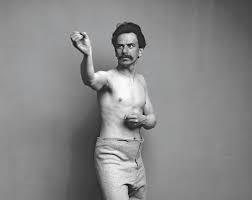
Mid-20th century to the Present
There was a push for a more scientific-backed discipline. Processualism as it would later be classified as was first introduced by Lewis Binford. He believed that there was a certain way that anthropological research should be conducted. His main goal was to develop the
field into a “hard science” by using the scientific method. His focus was on the sub-category, archaeology and how the material evidence was identified.
Archaeological data would be classified into either Technomic (technology/tools, socio-technic (social/relation to social subsystems), and ideo-technic (ideological/ rationalizations in social system)
There was a push for reflection of traditional anthropological research- especially that of the study of race/racism.
Tody anthropological theory mostly focuses on the reflection of traditional anthropological theories
A launch of a public initiative titled, “Race: Are We So Different?” by the American Anthropological Association (AAA)”
Social and Political Beliefs of the time
There was a rise in criticisms and challenging of early anthropological theories. This was due to the rise in the fight for equality by several groups (women, gays and lesbians, African Americans, and Native Americans) with The Civil Rights movement being one of the largest movements.
This was evident by the rise in more people of color entering the discipline.
Processualism as a whole was mostly influenced by the academic community and trying to make it into a scientific discipline. A byproduct of this was ignoring the racist ideologies of past anthropological theories
There was a continued push for reflection and change in the academic community following the Civil Rights Movement.
Anthropology not influenced by society?-Counter
With the use of science, there was this idea that it created an unbiased way of interpreting information, and the outside factor was irrelevant. While it is true that science can be objective, scientists aren’t. Scientists choose what they study and can interpret data in different ways. Due to this, science will only ever offer a glimpse of objectivity. Physical anthropology used a scientific justification with the use of the cephalic index and the systems created based on the data collected for racial classifications. It is important to recognize that just because something claims a scientific basis, doesn’t make it so.
What does it mean when there is anthropological theories developed counte the predominant anthropological theory? Anthropologist like Gordon V. Childe was heavily influenced by Marxist theories. He developed/presented his theories during a time in which Marxism was heavily criticized. While he was still able to publish his works, it was much harder and prevented him for being recognized for his contributions to the field.
Just because there are examples of anthropologists developing theories counter to the prominent political and social beliefs of the time, it doesn’t mean that there can't be a relationship between the two. Rarely in life do you see everybody agree on a single thing. Take “4 out of 5 dentists recommend (blank) toothpaste” for example. The overall opinion of the toothpaste doesn’t change if one disagrees. In the case of anthropological thought/theory, anthropologists remained influenced by political/social beliefs.
While these are good reasons to dispute my claims, there isn’t enough data to support this claim.
Conclusion
The evidence supports the idea of the inter-connected relationship between prominent social/political beliefs and anthropological thought/theory. From the foundation of early anthropological theories in the eighteenth century to the present, anthropology has been formed and reformed by the ideological movements of its time. Creating a lens through which anthropologists can view and interpret cultures, reflecting the wider societal mindset, and forming a dynamic relationship between Academic research and the cultures it seeks to understand
Much of early anthropological thought/theory was rooted in the personal biases of the anthropologists conducting research. They would use religion and “science” (what we would call today pseudoscience) as justification for their beliefs. Franz Boas would become one of the first anthropologists to question this idea as his research found that the earlier thought/theory didn’t reflect his findings. This would later be called Boasian anthropology (named after its creator). This would be the driving belief into the 1960s, where anthropology would then focus on the criticism of early anthropological thought/theory and processualism which was influenced by the many movements pushing for equality. More anthropologists of color and more research on black culture were conducted. Today we still reflect on and criticize early modes of anthropological thought with the continued push for equality.
In conclusion, some may try and argue that there is a distinction between predominant social/political beliefs and anthropological thought/theory, its relationship is undeniable. To study anthropology is not to view it statically but dynamically. It is important to recognize that anthropology isn’t just a story about a culture it studies, but also about the anthropologist’s narrative and how it is influenced by society.
89 notes
·
View notes
Text
I want to argue that Dracula is the first work of Nokiawave.
-It's heavily concerned with new technology which drives the plot: Telegrams between everyone being collated into the text, Dr Seward's audiolog on the phonograph which Mina types up, mass transit in the form of both trains and Tube, steamships (and specifically the contrast between steam and sail) and loads of minor examples.
-It's concerned with new social technologies and social change: Mina is a typist, a respectable modern job for a young middle-class woman. Jon is a clerk and is working in an exciting emerging market. Dr Seward uses all the modern methods and keeps up with theory and scientific developments. Lucy is pleased to have plenty of male friends, not just to be seeking to marry. And it contrasts this with both the "good" Old Ways - The helpful, hopeless, peasants who give Jon his anti-vampire icon, the "broad minded" but also clearly steeped in superstition Van Helsing - and the "bad" Old Ways - Obviously, Dracula and also the enslaved Roma (Who, oh god, I I have to write about them in the context of Romanian chattel slavery of Roma, which was technically abolished in stages throughout the 2nd half of the 19th century, but where emancipation came with enforced sedentarism and obligation to a landowner - And where many remained enslaved in all practical terms into the C20th, and specifically in Transylvania the effects of Maria Theresia's Four Decrees that were still in effect that meant they would both be indentured to a landowner as "new farmers" and their children would be kidnapped by the state and given to white families for "reeducation" - but most people analysing the text seem to treat them as willingly Evil Minions).
-It's full of the anxieties about what Eastern and Southern Europe will do as they "modernise and open" (ie become financially and culturally available to the West) and specifically the fear of the Rich Slavic* Oligarch (to a certain kind of British mind, anyone east of Berlin and north of Athens is Slavic, sigh) spreading their malign influence in the Capital Cities of the West. Even the touch that Dracula was once a warlord but is now a slick investor and man-about-town.
-It has lots of continent hopping, focusing on the ~local colour~ in Transylvania and the contrast between both the "superstitious" locals and the traveller who finds it all very quaint and interesting but not very serious, and between the poverty of the normal people and the wealth and seclusion of Dracula, and then likewise giving us whistle-stop tours of the interesting bits of Whitby and London, making the city as much of a character as the humans. The Westerner abroad is seen as just a natural phenomenon, but the foreigners* in Britain are notable and exotic.
- It has a mysterious superweapon/monster which is hidden around a big western capital city, where most people (and even the police and regular military) have no idea what it is and are powerless to stop it, and a lot of tension lies on the crux of "What happens if this gets out here, surrounded by all these civilians?" - In a way that treats the mythological East* as a natural place for atrocities to occur, but them happening in London is a shock.
-It has spying: Jon sneaking around the locked-up Carfax with his miniature camera, trying to take pictures to find out what Dracula is doing in there, could have absolutely been in a 1990s thriller. Likewise, meeting in Harrods to avoid suspicion because it's a plausible place for a fashionable young lady to be, surrounded by anonymising crowds.
-It has information warfare: Dracula reading up on British politics, studying maps of London, paying clerks and using shell companies to disguise his property acquisitions, and likewise the heroes using the telegram and port records and the sheer mass of paperwork generated by his activities to track Dracula, which feels like close kin to the Nokiawave staples of finding someone on cctv or by their credit card, or their car registration being flagged at a checkpoint. Jonathan lamenting the lack of an Ordnance Survey in Europe and the unmapped bits of Transylvania specifically really fits with the idea of the "Control Grid" posited by Gregory Flaxman who writes a lot about surveillance and information control in cinema.
-It has a team of both specialists and laypeople who were dragged into the action by circumstance, and much relies on their relationships. The laypeople's "unimportant" skills (Jonathan's knowledge of property and finance especially, and Mina's skills with logistics as well as her innovation and bravery in using herself as a conduit to Dracula) turn out to save the day. The team is multi-national and basically represents The Free World (TM), as well as allowing for jokes about national stereotypes.
-Mina being notably not a damsel in distress, but instead using her personal connection to the villain to absolutely ruin him in ways that nobody else could, is very much like the role of many women in Nokiawave films: She may be traumatised and in danger, more than anyone else because of the villain's obsession with her, but she's smart and deadly and willing to take risks to complete the mission.
-It ends with a massive cross-continental vehicle chase with tonnes of explosions.
146 notes
·
View notes
Text
11 year old Gerry Kaey - a psychological analysis

[ID: screenshot from a spreadsheet of two columns and two rows. The first column is labeled “First Name,” with “Gerard” listed below it. The second column is labeled “Last Name,” with “Kaey” listed below it. End ID]
Like everyone else, I was of course delighted by the presence of our beloved arsonist on our list of child test-subjects at the World Line 2 Magnus Institute (not delighted that he was having unethical psychology experiments performed on him, delighted by his presence. though it’s possible that this was actually a better childhood than he had with Mary. but I digress.)
(Data set can be found here, if anyone else wants to make a copy and play with it, and this post has my fave analysis of the sheet itself)
The data for Gerard Kaey was absolutely delightful, and it indicated more than almost anything else that some people were in fact the same (or very similar) across world lines. I was going to post about it and then I remembered that not everyone was forced to take a slightly outdated Educational Psychology class recently, and thus the random names at the top would not be indicators of fuckin anything without extensive Googling.
I figured trolling the internet for details on outdated developmental psychology theories and unethical sociology experiments is not most people’s idea of a fun afternoon (tho in the magnus fandom you never know); either way I figured I’d pull out the fun and interesting data on this goth child and translate it into human terms for us all to enjoy.
(QUICK NOTE: Pretty much all of these theories are outdated on account of being No Good and quite reductive and many of the experiments are EXTREMELY fucked up (all of which makes sense, given where these fictional data came from). If you’re curious about any of the actual psychological theories and criticisms, here’s a relatively jargon free summary, with further reading at the bottom. I’m gonna follow the time-honored tradition of psychology professors and say “well it sucks and was bad that this happened BUT it did happen and we might as well use the data to come to some general conclusions and/or ask better questions, especially about the people performing those tests in the first place.” anyway ty for coming to my TED talk ONTO THE GERRY DATA)

[ID: screenshot from a spreadsheet of three columns and two rows. The first column is labeled “Kholberg,” with “Level 3” listed below it. The second column is labeled “Prosocial,” with “High” listed below it. The third column is labeled “Empathy Index,” with “95%” listed below it. End ID]
Let’s start here.
Kholberg’s Theory of Moral Development is a metric for measuring the moral development in children. It has three stages. A child who has reached the “third stage” demonstrates a consideration of the needs and feelings of others when making morality-based decisions and judgements, even above the norms and expectations of society.
Prosocial behavior is behavior that can be characterized as having no direct benefit to the person performing an action; something done entirely for the good of others.
Empathy Index is pretty self-explanatory (as far as I can tell, it’s not actually based on anything and is something the researchers created just for this experiment).
So far, we’ve got a rough picture of Gerry as a kid who has a strong moral compass, who is quick to help, even when there’s no benefit for himself. Who considers what the people around him might want or need. Who is able to throw social expectation out the window when someone else is in need.
Reminds me of that older, slightly different version of himself, sitting alone at a table in Venice, wearing a Hawaiian shirt because he’s “on vacation,” sighing in exasperation at the interruption and telling a stranger to think of her mother.

[ID: screenshot from a spreadsheet of two columns and two rows. The first column is labeled “Milgram,” with “Low” listed below it. The second column is labeled “Asch,” with “Low” listed below it. End ID]
These are my favorite rows. They’re all the way at the end of the spreadsheet, which kind of makes me imagine that the testers had this image of a highly developed child, a kid who seemed perfect for whatever they had planned. And then…
Milgram was the motherfucker who ran the experiment where people were told to press a button, and when they did, another participant was delivered an electric shock. (there wasn’t actually a shock in Milgram’s experiment, just an actor pretending to be shocked. The socks were fake, but the psychological damage was real!) The test was designed to measure how long people would continue to do what they were told by the “scientist” running the test, even as the electric shock appeared to grow stronger. A “low” score is indicative of someone who bailed out ASAP, no matter what the test-runner said.
The Asch Conformity Experiment put a large number of people in the room (most of whom were actors) and showed them a series of images of lines with different lengths, and they had to identify which was longest. The actors all gave the correct answer for the first few, and then all of them started to give the exact same wrong answer (i.e. all of them would say B, even if Line A was clearly longest). The test measured how likely a subject was to conform to the group opinion, even when they knew the people around them were objectively wrong, if they were the only one offering a different (but correct) answer over the course of several rounds of images.
I have this super clear image of little Gerry in a ratty pair of jeans and a band t-shirt, long hair absolutely unbrushed, walking into a room with a dude in a lab coat and someone else strapped to a chair and IMMEDIATELY getting suspicious, and just refusing to press the button again once he realized what it did, leaving the actors just… lost as to how to proceed. And then with the Asch test, he’s just sitting there with a look of incredulity on his face looking at the people around him and saying “do you people need fucking glasses all of a sudden? it’s not fucking B.” and just ignoring them for the rest of the test.
and all of the Magnus people who had been VERY excited about this promising young person all of a sudden realizing that they have accidentally recruited a VERY intelligent juvenile delinquent.
so there you have it! World Line 2 Gerry Kaey was kind when he didn’t have to be, he didn’t give a shit how other people felt about him, he cared deeply for other people, UNLESS of course they were people in authority, in which case he told them to go fuck themselves.
*dreamy sigh* that’ll be our Gerard
final fun notes:
Gerry has the second highest number on the Empathy Index at 95%
The only kid who beat him, with a score of 98%, was 9 year old “Samara Khalid”
10 year old “Conner Dyer” scored “Low” on the Milgram and Asch tests JUST like Gerry. I wonder if they were friends.
Other than that, Dyer is almost exactly average among the rest of the data
Khalid scored “High” on both Milgram and Asch
Wonder how that’s gonna affect things 👀👀👀 high empathy, high value on what other people think
Sam thats so autistic of you I love u
Khalid was also on “Level 3” of Kholberg and had “High” levels of Prosocial behavior, despite being only 9 (super young to have the abstract thinking necessary for that)
#long post#tmagp#the magnus protocol#gerard kaey#the magnus institute#tmagp meta#gerry kaey#tmagp spoilers#tmagp arg#I have so many wikipedia pages about psychology open on my bowser#anyway I hope you ENJOY#I was gonna just make a post with the screenshots and the ‘that’ll be our gerard’ but then I realized that would be fucking inscrutable#so now we have this#yw#(???)
51 notes
·
View notes
Note
what do you think is the reason for only Tyler, Angel Face, and Bob (and the Narrator) to have hair while everyone else has mostly shaved it off? I have my own theory, but I'd like to hear what you think.
Realistically: they're all the higher profile actors, lol. Very simple truth of it. For stuff like that, that's obviously a result of studio oversight and pr teams both not wanting their darlings to be shaved, I don't bother making an in-story reasoning.
That said,
the narrator himself does not shave his head in both the book and movie and it points to his lack of commitment. In the movie he doesn't participate in Project Mayhem at all unless Tyler's there pushing him, he can't let go and follow Tyler, not even if it just means a haircut. Unless Tyler's there to baby and bully him through, he's stuck in inertia. In the book, he's much more into Project Mayhem, taking Tyler's orders from the mechanic. But he's an automaton. You feed orders in, get results, and he commits to nothing else. It doesn't even cross his mind to develop further. Again, inertia. Slightly different flavor.
Part of what likely holds him back, too, is that Tyler hasn't told him to; in the movie, that means maybe he's special. He wants to be special. Movie narrator can't let go of that beautiful little stage where it was just him and Tyler and he was Tyler's little pet project and they were able to do stupid shit and tell society to fuck off but he could also get paid or at the very least didn't have to wrestle with the fact that his darling Tyler isn't content with just them becoming asocial recluses. Tyler wants change for everyone, not just him. In the book, it moreso means he's very much out of the loop. The space monkeys only start shaving their heads after he's collected his 12 human sacrifices and is going cross country trying to find Tyler. His priority is finding Tyler. And then he finds out he is Tyler. No time left.
#asks#in the book the space monkeys all shave their heads and burn their fingerprints off all at once and I don't believe Bob and Angel Face and#even Tyler are separate#fight club
45 notes
·
View notes
Note
The boys look like puppets on strings so cool! I wonder what’s the meaning behind Ortho, Ace and Kalim being chosen as SSR this time. I understand Ortho being non-human like Pinocchio but kinda lost on Kalim and Ace. Although Ace’s surname is Italian.
THEY DO I FUCKING LOVE IT !!!
So so so1! I really think Ace, Kalim, and Ortho being the SSRs makes so much sense because of the theme of Pleasure Island. Pleasure Island in Pinocchio is a place where boys that are led to there could have all the fun they wanna do—play games, smoke and drink, etc. But then that comes at a price: the longer they stay there, the more they will transform to donkeys until they are fully donkey and are made to work.
The event summary somehow gives confirmation too that they're gonna follow this concept:
A select number of NRC students are invited by the strange man Fellow Honest and his apprentice Gidelle to spend their time in the illustrous amusement park, Playful Land. Just for one day, you can play as much as you want. No school for that day, you can even become a star on the stage! However, there is one thing that you must take note and remember. Never forget your "good conscience"...
(TL by my friend @shuuenmei)
From here alone, Ace and Kalim make sense. They're both troublemakers, with Ace being... well, Ace. And Kalim, while he doesn't intend to, does things on a whim, which inconveniences people especially Jamil. They're also materialistic. Ace in book 6 keeping the money for himself, and the way he talks about fashion and shoes, indicates this. And Kalim... is Kalim. They've got their indulgences.
But on the flipside, they have their moral compasses. Ace's moral compass is especially seen in Book 1 and Ghost Marriage—dude will call out people. And Kalim's resistance to Jade's unique magic in book 4 displays the strength of his own values.
Ortho fits this too. He is less of a troublemaker than Ace and Kalim, but his penchant for laser beams isn't the best either (as seen in Ghost Marriage and Uniform Ortho story). In FG Ortho story, Ortho tells Riddle about the time he skipped class and Trein scolded him for it. Riddle also told Ortho to not skip class, but he understood too that it's because Ortho's used to not getting told off for skipping before officially enrolling into NRC. He does have a good heart, though, and he is developing his own values as he's now more human than pre book 6. And as the character most resembling Pinocchio, it would be really interesting to see how he deals with Playful Land.
Hope this makes sense! There's honestly a lot of theories and speculations that you can make with this. But this is how I interpret it right now.
121 notes
·
View notes